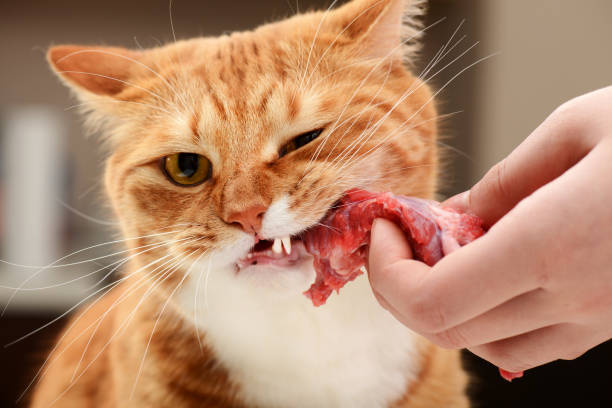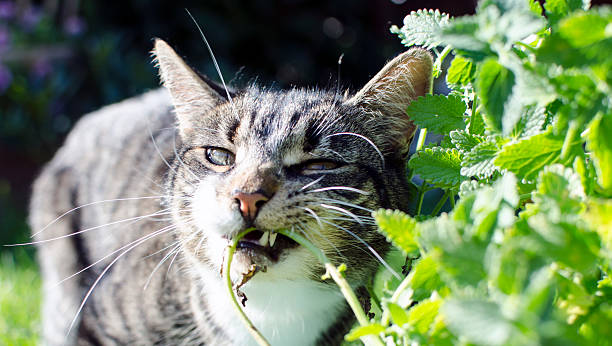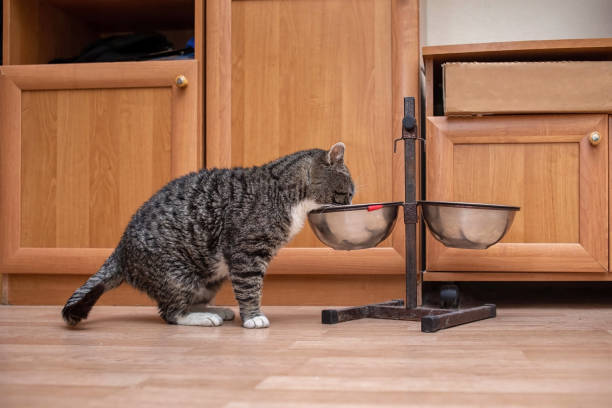Balancing Your Cat’s Diet
A balanced diet is a key component of your cat’s health. It should be high in animal protein and low in carbohydrates, fat, and calories.
Consider your cat’s weight and body condition score when selecting a diet. Make any changes gradually. Your veterinarian will help you decide what type of food to feed your pet.
Meat
If you are making your own cat food, start with finely ground meat and bones. If your cats will accept chunks of raw meat then start adding them (be sure to use a balanced recipe and do not get too creative or you could be introducing unnecessary bacteria).
Make sure that any ground meat you buy is from a quality source. Grocery store ground meat has the potential to contain higher levels of pathogens than a commercially prepared diet because it is not handled with the same standards.

Try to include organ meat in your cat’s diet as this is very close to their prey-based diet and will help them get the taurine they need. Also, add some green tripe if you can find it; it is a very rich and nutritious supplement for cats. This is especially important for pregnant or nursing cats and for those with health issues that require close monitoring of protein intake.
Fish
As a protein source, fish is very nutritious for cats. It is high in taurine and provides a good supply of fats, vitamins, amino acids and omega-3 fatty acids. However, it is not a natural part of a feline diet. Moreover, fish often contains bacteria (like salmonella and E. coli), mercury and other environmental contaminants. Feeding raw fish can also lead to gastrointestinal problems, infections and allergic reactions in some cats.

A small amount of cooked fish is acceptable as an occasional treat, such as tinned sardines in spring water or grilled salmon. However, if fed regularly, it could deprive your cat of essential nutrients and cause health issues.
Avoid feeding predatory fish like tuna and salmon (their position at the top of the food chain means they have higher levels of heavy metals such as mercury) as well as king mackerel and shark. And do not feed octopus as it can be toxic and may contain harmful bacteria.
Vegetables
Cats are obligate carnivores, but many owners like to supplement their pet’s diet with vegetables to add vitamins and minerals. While most vegetables are safe, some can be toxic to cats.
Vegetables contain magnesium, potassium, and fiber, which are essential nutrients for your pet’s health. However, they are best fed as a snack and should not replace their primary meal source. It is also a good idea to run any major dietary changes by your vet before making them.

For example, kale is rich in vitamin A and fiber and provides a natural source of nitrates (which are converted into nitric oxide to improve blood flow and stamina). Cooked carrots are a great treat for your pet. They provide a source of fiber, vitamin A and beta-carotene.
Avoid feeding your pet any vegetables that are not ripe or washed thoroughly. Unwashed vegetables may contain toxins or pesticides. In particular, members of the allium genus, such as onions, chives and garlic, are toxic to cats because they contain sulfur-containing oxidants that damage red blood cells. This results in anemia. Symptoms of toxicity include vomiting, diarrhea and lethargy.
Fruits
A small amount of fruit can be beneficial for a cat’s diet as it adds variety, and provides additional vitamins, minerals and antioxidants. However, it’s important to keep in mind that fruits can be high in sugar and should be consumed in moderation.
Berries are a great source of vitamin C, potassium and fiber and can help strengthen your cat’s immune system. They can also aid in digestion and weight loss. Bananas are another good choice, they are low in calories and provide Vitamins B6, A and C. Just make sure to remove the stem and seeds as they can be toxic to cats.
While most fruits and vegetables are safe for your cat to eat, it’s important to remember that they should not make up more than 10% of his daily calories. It’s also best to offer them as a treat or supplemental snack and make sure they are cut into bite-sized pieces.
Catnip
The catnip plant (Nepeta Cataria) is an intoxicating herb that activates a feline’s “happy” brain centers. When exposed to catnip, most cats become relaxed or hyperactive and may roll around in it or play with it. However, some cats don’t react to it at all and some become aggressive when provoked. This is due to genetics and personality-driven responses.

While catnip is safe for most cats, ingesting too much can result in digestive distress like diarrhea and vomiting. It’s also important not to over-stimulate your cat with this herb and to keep it away from their bedding or toys when they aren’t interacting with it.
Paying attention to your cat’s nutrition is an excellent way to help them live longer, healthier lives. Healthy diets reduce the need for expensive veterinary care, as they will prevent many health problems that are caused by poor nutrition.
Treats
Treats can be used for bonding and training, but too many treats can lead to weight gain. Ideally, treats should not be given more than 10% of the pet’s daily calories.
When a cat’s meals are supplemented with too much treats, proteins can be overtaken by the extra calories, causing nutritional imbalances. Also, excessive treats can cause cats to avoid their own food, leading to malnutrition and other health problems.
It is important to make sure any non-food items given as treats (such as pigs’ ears or pizzle sticks) do not contain bones, skin, hair or meat trimmings which may carry bacteria such as salmonella and E. coli that can be dangerous to cats and humans.
Veterinary nurses can help pet owners choose the right treats for their pets by suggesting they look for ones manufactured by a dog or cat food company, as these are usually formulated to meet specific nutritional standards. They can also ask their clients to check the product label for a statement of nutritional adequacy or calorie count.

